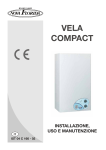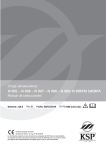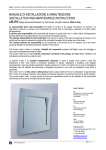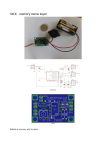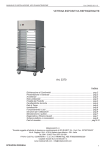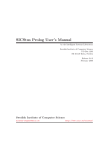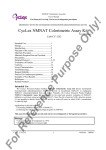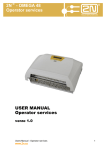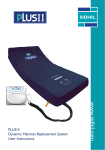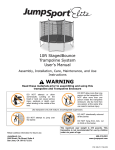Download Wheeled Stair Climber N 911 - 912 - 913 YACK instruction
Transcript
Wheeled Stair Climber N 911 - 912 - 913 YACK instruction manual Number: 110.5 Rev: C Date: 01/04/2014 Class I medical device Directive 93/42/EEC - DL 46 24/02/1997 The information in this manual is the property of KSP Italia Srl and may not be reproduced, in whole or in part, or used for any purpose other than that for which it was provided, without written authorization from KSP Italia Srl. File no.: MD-110.doc Contents 1. IDENTIFYING DATA Pag. 4 2. DECLARATION OF CONFORMITY Pag. 5 3. THE MANUAL Pag. 6 4. WHO IS IT FOR Pag. 7 5. GENERAL WARNINGS Pag. 8 6. Simboli grafici Pag. 9 7. LABELS Pag. 11 8. DESCRIPTION AND INTENDED USE Pag. 12 9. TECHNICAL FEATURES Pag. 13 10. USER INTERFACE, CONTROLS, INDICATORS, BUTTONS, ADJUSTMENTS AND HANDLES Pag. 15 11. TRANSPORT HANDLING UNPACKING Pag. 19 12. ASSEMBLY Pag. 22 13. FIRST START-UP Pag. 27 14. 14.1 14.2 14.3 14.4 14.5 14.6 14.7 14.8 14.9 14.10 14.11 YACK N 911 CONFIGURATION Power-on, check, adjustment Climbing stairs Descending stairs Climbing and descending at different speeds Continuous-cycle climbing Continuous-cycle descent Climbing and descending at different speeds Operations with passenger Climbing sequence with passenger Descending sequence with passenger Checks Pag. 28 28 29 30 31 31 31 31 31 32 33 33 15. USE Pag. 34 16. YACK N 912 CONFIGURATION Pag. 36 17. ADJUSTING AND FASTENING THE WHEELCHAIR - YACK N 913 Pag. 38 18. ENERGY-SAVING METHODS Pag. 40 19. CHARGING THE BATTERIES Pag. 41 20. INHIBITION CONDITIONS Pag. 42 21. TRANSPORT Pag. 43 22. FORESEEABLE IMPROPER USE Pag. 44 23. INSTRUCTIONS FOR EMERGENCY SITUATIONS Pag. 45 24. TROUBLESHOOTING Pag. 46 25. MAINTENANCE Pag. 47 26. PERIODIC MAINTENANCE Pag. 49 27. DISPOSAL Pag. 50 28. WARRANTY Pag. 51 03 Instruction manual (110) 1. Edition A Identifying data Stair climber YACK N 91x 2009 Serial no. Carefully read the instructions for use II IPX4 24 V DC 20 A Standards applied - Directive 93/42/EEC - ISO EN 1041 - ISO EN 1441 - ISO EN 980 - ISO EN 60601 04 Safe work load 130 kg 220 W Instruction manual (110) 2. Edition A Declaration of Conformity KSP Italia S.r.l. Via dell’Artigianato, 1 06031 Bevagna (PG) - Italy Tel. 0039 0742 361947 Fax 0039 0742 361946 [email protected] www.kspitalia.com KSP Italia declares and guarantees that the products described below: Code Name YACK Stair climber N 911 Stair climber with seat YACK Stair climber N 912 Stair climber for wheelchairs YACK Stair climber N 913 Stair climber that can be hooked to wheelchairs - are classified as Class I medical devices pursuant to Annex IX of Directive 93/42/EEC (as acknowledged by Legislative Decree 46/1997), - conform to Directive 93/42 “medical devices” and satisfy the essential prescriptions of Annex I, Directive 93/42/EEC - conformity for the purposes of applying the CE mark has been assessed pursuant to the procedure required by Annex VII of Directive 93/42/EEC - the requirements for electromagnetic compatibility were assessed pursuant to the Harmonized Standard EN 60601-1-2 These devices have been officially published in the Repertorio dei Dispositivi Medici (list of medical devices available in Italy) kept by the Ministry of Health pursuant to the Ministerial Decrees of 20th February 2007 and 30th March 2007. All the products are constructed in conformity with current occupational safety standards, with particular reference to the Consolidated Safety Law, Legislative Decree 81/2008 and subsequent modifications and additions. The Legal Representative Claudio Emanuelli 05 Instruction manual (110) 3. Edition A The manual This use and maintenance manual, together with the instructions provided on the label, is the information provided by the manufacturer in conformity with Directive 93/42/EEC. Each device must be accompanied by the information necessary for safe use, keeping in mind the training and knowledge of potential users. This manual is an integral part of the medical device and must be carefully preserved. It is intended for users, the owner, those responsible for safety and maintenance personnel. It provides information about the technical characteristics, correct use, transport, storage, maintenance and disposal of the device as well as the associated safety recommendations; however, this manual is no substitute for adequate user training. The manufacturer will promptly notify owners of the product of any changes to the instructions that affect the safety of the patient or user. Other changes and/or additions are excluded from the obligation to give notice. If this manual or the labels and/or markings on the product are completely or partially damaged, faded or illegible, you must immediately request a copy from your reseller or the manufacturer. This manual refers to the products YACK N 911, YACK N 912 and YACK N 913. Where not otherwise indicated, the instructions are to be understood to apply to all three versions of the stair climber. The peculiarities of one or the other model will be explicitly highlighted. 06 Instruction manual (110) 4. Edition A Who is it for The manual has been written taking into account the characteristics, knowledge, cultural level and training of the user. The user must have the following characteristics: - Older than age 18 - Physically strong and emotionally healthy - Able to evaluate hazardous situations and act calmly and thoughtfully - Excellent knowledge of spoken and written English - Knowledge of the meanings of symbols and markings We also wish to remind you that a necessary condition for using the YACK 910 stair climber is participation in the specific instruction and training in the operation of the device provided by the manufacturer or authorized reseller, with the issuance of a written certificate. 07 Instruction manual (110) 5. Edition A General warnings To verify the suitability of the environment where the stair climber is to be used, you may request a free on-site inspection and demonstration, which will be performed by authorized personnel for the purpose of ascertaining the compatibility of the device for its environment of use. Upon delivery of the stair climber: - If the device has been damaged in transport when you receive it, do not use it, but contact the technical support department to have it checked and repaired. - When the stair climber is delivered, the authorized personnel will perform a free series of demonstration tests and issue a document attesting to training and education for its use. - The above document will indicate the person, identified as the operator, who should be the only person to use the stair climber. - It is a good idea for the operator to use the device without a person on board, performing all the steps of climbing and descending, in order to become as expert as possible in its use. - The stair climber must be operated by a person who has the physical capacity to control the mass of the device and the person transported. - The operator must be completely familiar with the contents of the manual. - It is essential that the operator check his ability to manoeuvre the device by practicing on a flat surface. - Before using the device each day, check that it is in good condition and that all of its safety devices are working. General warnings: Never use the stair climber on surfaces that are wet, smooth or slippery, waxed, icy or similar, that do not ensure the operator’s stability or the action of the wheel brake. - Carpets and mats can be hazardous. - While on the stairs, never let your grip on the stair climber go for any reason. - Make sure that no one is below you while you are travelling on the stairs. - Make sure the passenger is seated and the safety belt is buckled. - Always wear closed shoes so as not to interfere with the moving parts; they should be tightly laced and have a non-skid sole. - Never stick your hands in the mechanism when it is moving. Disposal: The stair climber is an electrical and electronic device that must be disposed of by KSP Italia or the APIRAEE consortium, whose mandate is the disposal of electrical and electronic waste. Such disposal is at no charge for the purchaser. Refer to the section on disposal for more information. 8 Instruction manual (110) 6. Edition A Graphic symbols Symbol Meaning Notes Mark of conformity to European Directives Safe work load WEEE Date of manufacture Alternating current Operating instructions Dangerous voltage Warning sign Warning or generic hazard Attention Dangerous voltage Moving parts Danger of crushing feet Prohibition sign Prohibition against the operator wearing slippers Prohibition against wearing shoes with heels Mandatory behaviour sign 9 Instruction manual (110) 6. Edition A Graphic symbols Symbol Meaning Notes Generic mandatory behaviour sign Refer to the instruction booklet Non-skid shoes required N1 = - 0 Unprotected - 1 Protected against the penetration of foreign solid bodies of Ø 50 mm and larger - 2 Protected against the penetration of foreign solid bodies of Ø 12,5 mm and larger - 3 Protected against the penetration of foreign solid bodies of Ø 2.5 mm and larger - 4 Protected against the penetration of foreign solid bodies of Ø 1.0 mm and larger - 5 Protected against dust - 6 Totally protected against dust Protection grade N2 = - 0 Unprotected - 1 Protection against the vertical fall of drops of water - 2 Protection against the vertical fall of drops of water when the HOUSING is inclined up to 15° - 3 Protected against rain - 4 Protected against sprays of water - 5 Protected against jets of water - 6 Protected against powerful jets of water - 7 Protected against the effects of temporary immersion in water - 8 Protected against the effects of continuous immersion in water NOTE: When a characteristic digit is not required, it is replaced with the letter “X” (“XX” if both digits are omitted). Fuse 10 Instruction manual (110) 7. Edition A Labels Stair climber YACK N 91x Serial no. 2009 Carefully read the instructions for use Safe work load 130 kg 11 Instruction manual (110) 8. Edition A Description and Intended Use The YACK N 910 is an aid for the disabled that allows persons with reduced motor capacity to overcome architectural barriers with the assistance of an operator. It is a Class I medical device as defined by Annex IX of Directive 93/42/EEC, and is constructed in conformity with Italian and international law on medical devices and aids for the disabled and officially published in the Repertorio dei Dispositivi Medici (list of medical devices available in Italy) kept by the Ministry of Health. The Stair climber is a mobile instrument that can be transported and used anywhere and on all types of stairs, ensuring complete freedom of movement and the passenger’s comfort and reducing the strain on the assisting personnel to a minimum. The stair climber is indicated for wheelchair-bound persons who need to be moved to different floors within a building with the assistance of a caregiver. It consists of a metal structure driven by a DC motor powered by a removable and interchangeable rechargeable battery. It is manoeuvred using a telescopic steering column with control buttons and is provided with interfaces for monitoring the battery and controlling its speed. Since it has wheels, the stair climber can tackle straight, curved and spiral stairs and wedge-shaped steps and needs reduced manoeuvring space. The control electronics have both continuous- and single-cycle modes. In the latter mode, continuous pressure on the start button generates only a single climbing cycle (corresponding to one step). Transport is facilitated by the possibility of disengaging the “guide” steering column from the body of the machine, the rotation of the handle and the presence of convenient grips for handling. The N 910 stair climber can be configured in the following three versions: - N 911 version with seat; - N 912 version with a mechanism for hooking a wheelchair complete with plates; - N 913 version with a hooking mechanism complete with customized brackets for hooking the wheelchair; The parts and accessories of all three YACK versions can be totally disassembled allowing them to be easily handled and stored. All the parts have minimal dimensions, are easy to transport and can be stored in small spaces. The stair climber is exclusively designed for the transport of persons as indicated in this document. It must be used within the limits and according to the methods explicitly described by the manufacturer in this manual. The manufacturer will not be liable for personal injury or property damage caused by use by untrained personnel, unauthorized modifications or repairs, the use of unauthorized spare parts, exceptional events or a total or partial failure to follow the instructions in this manual, which must accompany the product if sold to third parties. 12 Instruction manual (110) 9. Edition A Technical features Basic N 910 machine 7 3 4 8 2 1 6 1. Machine body 2. Steering column 3. Handle 4. Control Panel 5. Step edge brake 6. Handle for manual lifting 7. Handle tightening knob 8. Removable battery 9. Tip-up armrests 10. Seat 11. Tip-up foot supports 12. Wheelchair hooking mechanism 13. Height adjustment for the hooking mechanism 14. Plate for wheelchair wheels 15. Board for hooking to the wheelchair 5 12 9 12 9 13 13 10 11 N 911 Configuration 14 N 912 Configuration 15 N 913 Configuration 13 Instruction manual (110) 9. Edition A Technical features Common technical characteristics - Basic YACK N 910 machine Electrical characteristics: Motor: DC Battery: Pb 5 Ah Rated battery voltage: 24 V Power absorbed during battery charging: 50W Internal fuse: 20 A Limits of use Maximum load: 130 kg Operating inclination of steering column: 20°-40° Storage temperature in a dry environment: -10 ÷ 50 °C Operating temperature: 10 ÷ 50 °C Maximum step height standard version 210 mm (280 mm upon request) Usable Minimum step footprint: 120 mm Maximum speed: 5 sec/step Independent operation: > 500 steps Noise: < 80 dBA Hand-arm vibrations: < 2.5 m/s2 Whole body vibrations: < 1 m/s2 Battery-charger: Input voltage: 220 AC Output voltage 24 VDC Specific technical characteristics 14 N 911 Configuration N 912 Configuration N 913 Configuration Base weight: 23 kg Weight seat with footrest: 5.1 kg Weight steering column tube: 7.1 kg Weight battery: 4.5 kg Weight back: 3.3 kg Total weight: 43 kg Base weight: 23 kg Weight steering column tube: 7.1 kg Weight battery: 4.5 kg Weight connection plate for wheelchair: 6.4 kg Total weight: 41 kg Base weight: 23 kg Weight steering column tube: 7.1 kg Weight battery: 4.5 kg Weight of board for hooking to wheelchair: 2.6 kg Total weight: 37.2 kg Instruction manual (110) 10. Edition A User interface, controls, indicators, buttons, adjustments and handles 5. Speed selectors 5a- decrease speed 5b- increase speed 6. Direction selector and motor start switch 7. Selector button continuous cycle/single cycle 8. Continuous cycle mode signal LED Red: continuous cycle Off: single cycle 9. Acoustic indicator 1. Power-on jack 2. Start-up LED Green: ready Red + continuous beep: overload Red + intermittent beep: battery dead Steady red: incorrect inclination (only for versions with electric inclinometer enabled) 3. Battery-level indicator 4. Speed indicator 8 7 5b 1 1 9 2 3 5a 4 6 Operator electronic panel The electronic control interface is activated with the insertion of the jack (1). The LED (2) turns green if the stair climber is ready to start; otherwise, it turns red to indicate the presence of anomalies due to an unsuitable climbing/descending inclination (only for versions with electronic inclinometer enabled) and the operation of the machine is inhibited. The status of the battery is indicated by LEDs (3) as follows: 1st level: maximum charge, all on (from top to bottom) 3 green, 3 yellow, 2 red; 2nd level: the first two green LEDs turn off, 1 green, 3 yellow and 2 red are lit; 3rd level: the last green and first yellow LEDs turn off, 2 yellows and 2 red are lit; 4th level: the second yellow LED turns off, 1 yellow and 2 red are lit; 5th level: the last yellow turns off, 2 red are lit and the buzzer sounds intermittently; 6th level: the machine is locked. 15 Instruction manual (110) 10. Edition A User interface, controls, indicators, buttons, adjustments and handles The LEDs (4) indicate the speed selected from the four available. To increase the speed, press the “+” button (5a) and to decrease it, press the “-” button (5b). The Stair climber can climb and descend at 4 different speeds in intervals of 10% of the maximum speed of 5 seconds/step (12 steps/minute). At power-on, the machine’s speed is automatically set at 100%. Velocità Led accesi 70% 2 80% 4 90% 6 100% 8 The LEDs (4) also signal an overload problem. If the weight carried exceeds the maximum allowed, after moving a few centimetres, the machine detects that the weight limit has been exceeded and immediately returns to the rest position. The six speed LEDs will flash and the buzzer will sound intermittently to signal the problem. The stair climber is, thus, inhibited until it is reset by removing and reinserting the start jack. The hold-pressed buttons (6) located on the handle are the actual operating buttons. When the operator presses the button away from himself, the stair climber descends the stairs ahead of the operator and when the operator presses the button towards himself, the stair climber climbs the stairs towards the operator’s back. Climbing/descending can take place one cycle/step at a time (LED (8) off ) or with a continuous, cyclical lifting movement for the entire time that the button (6) (LED (8) on) is pressed. The mode is selected with button (7). 16 Instruction manual (110) 10. Edition A User interface, controls, indicators, buttons, adjustments and handles Handles and operator controls 11b 11a 10. Steering column fastening knob 11. Handle height fastening (11a) and positioning (11b) knob 12. Battery fastening knob 13. Battery charge outlet 13 12 10 Yack N 911 Configuration (with seat) 2 Macchina base Yack N 910 14 14. Armrest fastening snap (N 911) 15. Seat fastening knob (N 911) 16. Wheel brake (N 911) 14 3 15 4 16 17 Instruction manual (110) 10. Edition A User interface, controls, indicators, buttons, adjustments and handles Yack N 912 Configuration (with connections for wheelchair) 17. Floating holding head 18. Stop spool 19. Clamp tightening handwheel 20. Wheelchair connection plate 5 17 18 6 19 20 Yack N 913 Configuration (customizable and hookable to the wheelchair) 17. Floating holding head 18. Stop spool 19. Clamp tightening handwheel 20. Lower hooking board 7 17 18 18 19 8 20 Instruction manual (110) 11. Edition A Transport, handling and unpacking Packing and Transport The device is packed in a carton that protects it from normal transportation vibrations. The package must be transported in the vertical position and avoiding shocks and jerks. Check the integrity of the packing upon receipt. If the packing is damaged, immediately notify the carrier that delivered it. Before operating a device whose packing reveals signs of damage, it must be checked by the technical support department or by personnel authorized by KSP Italia. Inside the packing, the disassembled product consists of the following parts: N 911 - Base of the stair climber - Steering column with armrests and handle in the transport position - Seat - Battery pack - Fastening and adjustment knobs - Power-on jack - Battery-charger - Documentation N 912 - Base of the stair climber with wheelchair plates - Steering column with wheelchair connections - Battery pack - Fastening and adjustment knobs - Power-on jack - Battery-charger - Documentation N 913 - Base of the stair climber with wheelchair anchor board - Steering column with wheelchair connections - Battery pack - Fastening and adjustment knobs - Power-on jack - Battery-charger - Documentation 19 Instruction manual (110) 11. Edition A Transport, handling and unpacking Handling and Unpacking To protect the operator from hazards deriving from the manual handling of loads (Directive 269/90/EEC), consult the section, Technical Characteristics, which lists the weights of the single parts. The person assigned to unpacking must be informed of the risks of these operations. This section lists the basic operations for correct handling. To lift the load correctly without risking harm to your spinal column, you must: 1 - Keep your back straight 2 - Keep your trunk erect 3 - Your body should be crouched 4 - The weight lifted must be kept as close to the body as possible 5 - For lifting loads that weigh more than 25 kg (if the operator is female, the load limit is 15 kg) ask others for help or use suitable equipment 6 - Do not store the products above shoulder height 7 - Bring the package to a suitable area for unpacking and assemble the two parts of the machine. 8 - Open the packing without using sharp or pointed objects that could damage the contents. It is a good idea to keep the original packing materials for future reshipment of the device (such as to the Service Department) because they will ensure safe transport. 20 9 Instruction manual (110) 11. Edition A Transport, handling and unpacking All the components are easy to grasp. For this purpose, the base has a handle on the front and a hand slot in the rear. 10 1 11 2 21 Instruction manual (110) 12. Edition A Assembly Prerequisites: The YACK must not be damaged or have dents from transport. A representative of KSP Italia, or personnel authorized by the manufacturer to educate and train users, must be present during the operator’s very first use of the product. The correct assembly of the product is an essential condition for its safe operation. Below, we provide the step-by-step procedure for correctly assembling the device. Package contents YACK N 911 1) Arrange the contents of the package on a flat surface and check that all the parts are present and in good condition. 3 1 2 4 7 The package must contain: 1. Qty. 1 Seat 2. Qty. 1 Machine body 3. Qty. 1 Handle/Steering column 4. Qty. 1 Battery pack 5. Qty. 1 Battery-charger: 6. Qty. 2 Seat fastening knob 7. Qty. 1 Power-on jack 22 6 5 Instruction manual (110) 12. Edition A Assembly 2) Insert the steering column in the base and tighten the knob as shown in Fig. 12 12 12a 12b 3) Place the handle in the operating position as shown below: a. Loosen the handle knob as shown in Fig. 13 13 13a b. Bring the handle upwards to the operating position (Fig.13a and Fig.13b) and tighten the handle with the tightening knob, as in Fig. 13c 13b 13c 23 Instruction manual (110) 12. Edition A Assembly 4) Insert the battery pack and tighten the knob as shown in the sequence in Fig. 14 14 14a 14b 5) Attach the seat to the upper pins, as shown in Fig. 15 and tighten the screw knobs as shown in Fig. 16 15 15a 15b 16 16a 16b 6) Move the armrests by lifting the snap and position them as shown in the sequence below: 17 24 17a 17b Instruction manual (110) 12. Edition A Assembly Contents of YACK N 912 package The Yack N 912 model is packed already assembled. The contents of the package are the following and are shown in Fig. 18: L’imballo deve contenere: 1. Qty. 1 Machine body with plates 2. Qty. 1 Handle-steering column with connection bracket 3. Qty. 1 Battery pack 4. Qty. 1 Battery-charger: 5. Qty. 1 Power-on jack For the assembly of the steering column with the machine body and the initial adjustments, refer to the procedure for model N 911. 18 2 1 3 5 4 25 Instruction manual (110) 12. Edition A Assembly Contents of YACK N 913 package The Yack N 913 model is packed already assembled. The contents of the package are the following and are shown in Fig. 19: 1. Qty. 1 Machine body with board for hooking to the wheelchair 2. Qty. 1 Handle-steering column with connection bracket 3. Qty. 1 Battery pack 4. Qty. 1 Battery-charger: 5. Qty. 1 Power-on jack For the assembly of the steering column with the machine body and the initial adjustments, refer to the procedure for model N 911. 19 2 1 3 5 4 26 Instruction manual (110) 13. Edition A First Start-Up Operation will be illustrated using the N 911 configuration (with seat); these descriptions are to be considered valid for all versions. Prerequisites: The YACK must be correctly assembled. A representative of KSP Italia, or personnel authorized by the manufacturer to educate and train users, must be present during the operator’s very first use of the product. During all operations of climbing and descending, the operator must be on the upper part of the stairs. 27 Instruction manual (110) Edition A 14. Yack N 911 14.1 Power-on, checks and adjustment Adjust the height of the handle and fasten it with the handle as shown on page 17. Insert the jack as in Fig. 20 and check the status of the battery charge. If the user interface shows the batteries operating in reserve (red LEDs (3) in Fig. 1), replace the battery pack with a charged one or charge it following the instructions in the section “Charging the batteries”. With reference to Fig. 1, select the speed using buttons (5a) and (5b) and single-cycle mode with button (7); check that the LED (8) in Fig. 1 is off. 20 28 20a 20b Instruction manual (110) 14. 14.2 Edition A Yack N 911 Climbing stairs a. Bring the empty stair climber to the flight of stairs where the device will be used. (Fig. 21) b. Position the stair climber with the wheels against the vertical riser of the step (Fig. 21a) c. Tilt the stair climber towards you (the operator) at an angle that is suitable and comfortable in terms of the slope of the stair, your (operator’s) body size, and the weight of the user and make sure that the red LED (8) Fig. 1 is off (single-cycle operation) d. Press the start button in the climbing direction (button tilting backwards) and energetically support the stair climber. Use your body to maintain the best balance until the end of the step climbing cycle. (Cycle as in Figs. 21b to 21e). e. It is recommended that you keep your body in contact with the stair climber, climbing and descending the stairs with the machine supported by your leg. This procedure increases the stability and safety of the movement, also increasing the comfort of the person transported. f. Repeat steps b, c and d up to the end of the flight. 21 21a 21b 21c 21d 21e 29 Instruction manual (110) Edition A 14. Yack N 911 14.3 Descending stairs a. Bring the empty stair climber to the flight of stairs where the device will be used. (Fig. 22) b. Tilt the stair climber towards you (the operator) at an angle that is suitable and comfortable in terms of the slope of the stair, your (operator’s) body size, and the weight of the user and make sure that the red LED (8) Fig. 1 is off (single-cycle operation) c. Slowly push the stair climber to the edge of the step until automatic end-of-footprint brake locks the wheels and you cannot go any farther. (Fig. 22a) d. Press the start button (6) in Fig. 1 in the descending direction (button tilting forwards) and energetically support the stair climber while maintaining your best balance until the stair descent cycle finishes. (from Fig. 22b a Fig. 22h) e. Repeat steps c and d up to the end of the flight. 30 22 22a 22b 22c 22d 22e 22f 22g 22h Instruction manual (110) 14. Edition A Yack N 911 14.4 Climbing and descending at different speeds a. Configure the device using buttons (5a) and (5b) for the various speeds (I, II, III and IV) and repeat the operations in points 2 and 3. 14.5 Continuous-cycle climbing a. Configure the device as in point 1, but selecting the continuous-cycle mode [with button (7)]. Make sure that the red LED (8) is on. b. Bring the empty stair climber to the flight of stairs where the device will be used. c. Position the stair climber with the wheels touching the vertical part of the step. d. Tilt the stair climber towards you (the operator) with the methods explained above. e. Press the start button in the climbing direction and hold it down . f. As soon as the lifting pin has returned inside the body of the machine, quickly move the stair climber to the next step, avoiding that the pin begins the next lift before the machine is in the correct position. g. Energetically support the stair climber while maintaining your best balance until the end of the flight of stairs. h. The continuous action can be interrupted by simply removing the pressure on the start button. 14.6 Continuous-cycle descent a. Configure the device as in point 1, but selecting the continuous-cycle mode. b. Bring the empty stair climber to the flight of stairs where the device will be used. c. Slowly push the stair climber to the edge of the step until automatic end-of-footprint brake locks the wheels and you cannot go any farther. d. Tilt the stair climber towards you (the operator) with the methods explained above e. Press the start button in the descending direction and hold it down. f. As soon as the lifting pin has returned inside the body of the machine, quickly move the stair climber to the next step, avoiding that the pin begins the next lift before the machine is in the correct position. g. Support the stair climber until the end of the flight of stairs. h. The continuous action can be interrupted by simply removing the pressure on the start button. 14.7 Climbing and descending at different speeds a. Configure the device using the different speeds (II, III and IV) and repeat points 5 and 6. 14.8 Operations with passenger a. Have the non-disabled passenger sit on the seat and buckle the safety belt. b. Adjust the height of the steering column to correctly balance the weight. c. Perform the preceding operations from points 1 to 7 with the passenger onboard. 31 Instruction manual (110) Edition A 14. Yack N 911 14.9 Climbing sequence with passenger a. Bring the stair climber to the flight of stairs where the device will be used. b. Position the stair climber with the wheels touching the vertical part of the step. c. Adjust the height of the steering column (the optimal adjustment is chest-high). Fig. 23 d. Tilt the stair climber towards you (the operator) with the methods explained above and make sure that the red LED (8) is off (single-cycle operation ) Fig. 23b e. Press the start button (6) shown on page 15 in the climbing direction and support the stair climber until the end of the step-climbing cycle. Figs. 23c, 23d, 23e f. Repeat the operation to the end of the flight of stairs. 32 23 23a 23b 23c 23d 23e Instruction manual (110) 14. 14.10 14.11 Edition A Yack N 911 Descending sequence with passenger a. Bring the stair climber to the flight of stairs where the device will be used. b. Tilt the stair climber towards you (the operator) with the methods explained above. If necessary, block the wheel with your foot as shown in Fig. 24. c. Slowly push the stair climber to the edge of the step until end-of-footprint brake locks the wheels and you cannot go any farther. Figs. 24a, 24b d. Press the start button (6) in Fig. 2 in the descending direction and support the stair climber until the end of the step-descent cycle. Figs. 24c, 24d, 24e e. Repeat the operation to the end of the flight of stairs. 24 24a 24b 24c 24d 24e Checks At the end of the operation: a. Check the integrity of the mechanical parts b. Check the status of the battery charge; make sure there has not been an abnormal consumption of energy c. Check that there are no strange odours of overheated electrical materials. d. Check that the battery is not overheated. Remember that the stair climber is an aid for the disabled and that it may only be used by persons who have been educated and trained for its specific use. Education and training must be provided by KSP Italia or by agencies/persons authorized by the manufacturer, with verification of what they learned and a certificate of qualification. The lack of the above documentation indicates unsuitability for use and relieves the manufacturer of liability for property damage and personal injury caused by that person. 33 Instruction manual (110) 15. Edition A Utilization Prerequisites: The YACK must be correctly assembled and have passed the first start-up tests. The user must have written certification to operate the stair climber and must have carefully read and understood the preceding sections, performing the required tests. During the use of the stair climber, the safety and well-being of the person being transported are the most important priorities. Then, follow the safety instructions at the beginning of this manual and all the advice received during the description of the device. If the passenger has generic back problems, we recommend that you maintain a low speed. In addition, the person transported must be calm and relaxed while seated on the stair climber. You must absolutely avoid abrupt movements by the person being transported. The passenger must keep his head erect and body against the seat. In addition, he must not carry any type of weight or objects. Also make sure that the clothing or limbs of the person being transported do not interfere with the movements of the stair climber. The instructions shown for the YACK N 911 are also valid for models YACK N 912 and Yack N 913. For these two models, add the instructions for hooking the wheelchair. Refer to the relevant chapters. For less expert users, and for the first uses, we recommend proceeding with the “one cycle at a time configuration” and speed I. 34 Instruction manual (110) 15. Edition A Utilization The operations of climbing and descending must be performed as explained in the section OPERATIONS WITH PASSENGER in Chapter 13, “First Start-Up” with the due attention to the sensitivities of the passenger. With the passenger onboard, the total mass of the stair climber is increased. When starting the machine using the handle buttons, the stair climber might respond with an impulsive movement without starting. Just release the button and press it again to start normally. This behaviour (which is perfectly normal due to the additional mechanical inertia of the passenger) is anticipated by the manufacturer and does not involve any risks for the operator or person transported. While climbing and descending, the operator must always grip the handle with both hands. During the climbing cycle, you will initially sense a slight forward movement that serves to overcome the projection of the step. After reaching the highest level, the stair climber moves backwards and lands gently, resting the wheels on the upper step. Hold down the button until the “one step at a time” command automatically stops the return of the lifting part with the support wheels. NOTE: All the controls must be held down to operate. If you selected single-cycle mode, holding down the control executes only one climbing/descending cycle, overcoming just one step. If you selected continuous-cycle mode, holding down the buttons executes the climbing/descending cycle continuously. Use on a Level Surface For transport on level surfaces, both with and without the passenger, the stair climber must be pushed or pulled manually using the wheels. During movement on a level surface, the lifting element must be completely retracted inside the base. Periodically check the condition of the wheels and make sure that there is no play or loss of integrity. 35 Instruction manual (110) 16. Edition A YACK N 912 Configuration Adjusting and Connecting the Wheelchair The YACK N 912 is a wheeled stair climber designed for transporting a person on a wheelchair. It is provided with a mechanism for safely attaching the wheelchair to the steering column. This mechanism must be adjusted and calibrated for the specific wheelchair. The adjustments are made with the wheelchair and without the passenger onboard, before performing the transport. The steps to perform in adjusting and connecting the wheelchair are: - Adjusting the plates - Adjusting the height of the connection mechanism - Adjusting the side of the connection mechanism - Connection - Holding “in contact” Adjustingtheplates Place the wheelchair in the middle of the Yak fig.25, manually adjust the width of the two platforms fig.26, so that the wheels of the wheelchair can climb properly and centrally fig.27 5 25 2 27 26 Adjusting the height of the connection mechanism The height of the connection mechanism is adjusted using the two red snaps (1) in Fig. 28. The height must allow the wheelchair to be locked at the best point on its frame, such as in Fig. 29. At the same time, pull the two snaps outward, manually making the bracket slide. 28 1 29 1 Adjusting the sides of the connection mechanism The wheelchair connection mechanism shown in Fig. 30 consists of a bar with telescopic ends (2) that include a locking clamp (3) tightened via a handwheel (4). 2 30 30a 3 36 30b 4 Instruction manual (110) 16. Edition A YACK N 912 Configuration Adjusting and Connecting the Wheelchair To adjust the connection mechanism sideways, loosen the knob (4) in Fig. 30b to open the locking clamp and slide the telescopic ends outwards to accommodate the wheelchair. Insert the power-on jack, check the charge status of the battery on the indicator on the control panel, select the minimum speed with the control (5a) on the panel (Fig. 31) and press the start button (Fig. 32) in the climbing direction (backwards). With this command, the stair climber will slowly tilt forwards to move to a suitable position for connecting the wheelchair (Fig. 33). Push the wheelchair onto the plates and brake the wheels (Fig. 34), close the telescopic ends so they grip the tubular frame of the wheelchair inside the clamp (Figs. 35-36). Make sure that the wheelchair is centred in relation to the stair climber and tighten the two handwheels (4) to lock the frame of the wheelchair to the clamp (3) - (Fig. 34). 31 32 33 34 35 36 37 Instruction manual (110) 17. Edition A Adjusting and Connecting the Wheelchair - YACK N 913 The Yack N 913 is a wheeled stair climber designed to transport a person in a wheelchair by hooking directly to the wheelchair with a special, customized anchoring system consisting of a board mounted on the machine body of the stair climber and hooks anchored in the lower area of the frame of the wheelchair. This mechanism must be adjusted and calibrated for the specific wheelchair. The adjustments are made with the wheelchair onboard without the passenger and EXCLUSIVELY BY THE MANUFACTURER OR PERSONNEL IT HAS TRAINED AND AUTHORIZED. Lower hooking board Model N 913 is supplied with the machine body complete with hooking board (1). The board will allow hooking the stair climber to the wheelchair by inserting it in the hooks (2) on the frame of the wheelchair (previously mounted by KSP ITALIA authorized personnel). 37 1 38 2 Connection procedure Position the wheelchair equipped with connection hooks near the stair climber (Fig. 39) and brake the wheels. Hook the stair climber to the wheelchair by inserting the lower hooking board in the guide of the hook on the wheelchair (Fig. 40), until it is inserted in its seat (Fig. 41). Secure the hook by inserting the locking pin (Fig. 42). 39 40 41 42 Connection hook Locking pin 38 Instruction manual (110) 17. Edition A Adjusting and Connecting the Wheelchair - YACK N 913 The upper hooking system is the same as that of model N 912, so refer to the methods shown on pages 36 and 37. When the wheelchair is correctly hooked, it is perfectly fastened to the stair climber, as shown in Fig. 43. 43 44 Since model N 913 doesn’t have wheel-support plates, it can remain hooked to the wheelchair even during normal movements and, therefore, will always be ready for use without having to be hooked on from time to time. Fig. 44. Moreover, with this hooking system the wheels of the wheelchair can be removed (if the model of wheelchair used allows it), in order to further reduce its dimensions and facilitate the use of the machine in especially narrow spaces. Fig. 45. 45 39 Instruction manual (110) 18. Edition A Energy-saving mode To provide longer battery life and better energy-saving efficiency, YACK stair climbers incorporate energy-saving functions. If no commands are given for a period of three minutes, the internal microprocessor cuts power to the motors and electronic circuitry, going into an energy-saving state. This state is indicated by the flashing of the green power-on LED and three consecutive beeps every three minutes. To continue using the stair climber, you must remove the power-on jack and reinsert it, as for a first start-up. 40 Instruction manual (110) 19. Edition A Charging the batteries The batteries must be charged without a passenger on board, using only the battery-charger provided. The electrical system to which the cable is connected must be grounded and protected as required by current law. Avoid using extension cords, adapters or other devices. The status of the battery charge can always be determined from the charge indicator LEDs. The level indicator only works when the power-on jack is inserted. The level shown is proportional to the stored energy and the battery is in reserve status when the last yellow LED turns off and there are only two red LEDs with an intermittent buzzer. 46 The batteries do not require any maintenance. Recharging the batteries when they are on reserve, or completely discharged, requires about 6 hours, on average, and can be done either onboard the stair climber or separately. THE BATTERIES MUST BE RECHARGED AT LEAST ONCE EVERY 30 DAYS, EVEN IF THE DEVICE IS NOT USED. Batteries left drained are irreversibly damaged. Charging operation with the battery onboard: a. Insert the battery-charger connector in the socket of the stair climber. b. Connect the battery-charger to the electrical grid During recharging with the battery onboard, the machine is completely inhibited and this state is indicated by the progressive and continuous lighting of the charge LEDs on the control panel. 47 48 49 50 Charging operation with battery outside the device a. Insert the connector in the battery charging socket. b. Connect the battery-charger to the electrical grid 41 Instruction manual (110) 20. Edition A Inhibition Conditions Here is a summary of the conditions in which all, or only some, of the functions of the stair climber are inhibited. STATUS PARTS INHIBITED ACTIONS TO TAKE During charging of the batteries Operation of the machine Disconnect the battery-charger and remove-insert the power-on jack Battery charge below the 5th level Operation of the machine Charge the batteries and removeinsert the power-on jack During the climbing or descending phases of the machine The control panel is inhibited Release the start command Releasing the control buttons during climbing or descending The stair climber immediately stops in the position in which it is found Press the controls During the beginning of movement, one command button on the grip of the machine is given the climb command and the other the descent command, or vice versa The operation of the machine is inhibited Release both controls and only press them one at a time During the execution of a climb or descend command, the opposite command is given with the other button The operation of the machine is inhibited When you release the opposite command, the machine resumes the interrupted cycle. If, instead, you release the first command, the machine executes the opposite command The machine is not used for 3 minutes The operation of the machine is inhibited Remove-insert the power-on jack 42 Instruction manual (110) 21. Edition A Transport To transport the stair climber safely, you must use the packing initially provided, if possible. The steps are the same as those for unpacking, but in reverse. 43 Instruction manual (110) 22. Edition A Foreseeable improper use Users must refrain from behaviours that, even if they seem to be risk-free, are not explicitly recommended in this manual. Foreseeable improper uses derive from: a. Normal carelessness and an unconsidered attempt to use the machine incorrectly Correct education/training and the selection of suitable personnel is essential. Education and training must be provided by KSP Italia or by agencies/persons authorized by the manufacturer, with verification of what they learned and a certificate of qualification. The lack of the above documentation indicates unsuitability for use and relieves the manufacturer of liability for property damage and personal injury caused by that person. The stair climber is not suitable for outdoor use, but only for use inside the home. b. An instinctive reaction during use in the event of malfunctions, accidents and breakdowns In the event of malfunctions, accidents or breakdowns, never leave the stair climber in the vertical position with the passenger onboard but stabilize it in the safe position shown in the section “Instructions for Emergency Situations”; do not attempt to solve the problem on the flight of stairs, especially with a passenger onboard. Ask other persons for help and never leave the passenger alone unless it is inevitable. c. Following the “path of least resistance” to performing a task The stair climber is only to be used to transport persons. Therefore, transporting objects is prohibited. The same goes for transporting persons who are holding objects. The single-cycle mode is preferable to the continuous-cycle mode. Unless you are expert in manoeuvring the device, always prefer this mode and the lowest speed. d. Foreseeable behaviour of certain categories (minors, the disabled, etc.) In this case as well, the selection of personnel and their education/training plays an essential role. Never allow unauthorized personnel to manoeuvre the device. In the absence of authorized personnel, remove the power-on jack and keep it in a secure place. Only authorize its use by personnel who have excellent knowledge of written and spoken English and who are able to read the manual and understand its contents and their importance. 44 Instruction manual (110) 23. Edition A Instructions for emergency situations Safe position When problems occur during transport, it may be necessary to place the device in its safe position; this involves inclining the stair climber in such a way as to release the end-of-step brake on the wheels (fig. 46), removing the power-on jack and delicately resting the stair climber on the flight of stairs. In this position, the stair climber is immobilized and stable. 51 POSSIBLE EMERGENCY SITUATIONS 52 ACTIONS TO TAKE Batteries die during transport - Place device in safe position as indicated - Change the batteries - If you do not have a battery pack available nearby, ask for help Generic breakdown during transport, inability to proceed - Place device in safe position - Ask for help The person being transported faints or is nauseated - Stop immediately and provide the necessary remedies - If necessary, place device in safe position - If necessary, ask for help The person being transported must be calm and relaxed while sitting on the stair climber. You must absolutely avoid abrupt movements by the person being transported. The stair climber contains electronic parts so, in the event of fire, only use a CO2 extinguisher. 45 Instruction manual (110) 24. Edition A Troubleshooting PROBLEM PROBABLE CAUSE POSSIBLE SOLUTION -The stair climber does not accept Climb/Descend commands - The power-on jack is not well inserted - The steering column is not correctly connected - The steering column contacts are oxidized or there are foreign bodies - The stair climber is overloaded (red indicator light and buzzer) - Insert the power-on jack correctly - Reconnect the steering column - Check and clean the contacts - Reduce the load - When the jack is inserted the LED remains off - Batteries completely dead - Internal fuse blown - Recharge the batteries - Replace the fuse - The batteries are not charging normally - Batteries or battery-charger broken - Contact the service department - Limited independent operation - Batteries dead - Contact the service department -Movement is intermittent - The contacts that transfer electrical signals to the steering column are dirty or oxidized - Remove the power-on jack, remove the steering column and clean the contacts with a dry cloth slightly damp with alcohol - Oil stains on the floor - Oil leaking from the motor reducer - Contact the service department - The seat belt doesn’t buckle correctly - Belt broken - Contact the service department - The stair climber makes strange noises when it is running - Transmission problems - Foreign objects being dragged - Contact the service department - Stop the stair climber and remove the foreign objects IMPORTANT: If, despite the checks and remedies, the device continues to have problems that limit its correct operation (even partially), the operator is required to contact an authorized service centre, or the manufacturer, immediately. 46 Instruction manual (110) 25. Edition A Maintenance This chapter describes the only maintenance that the user is allowed to perform. All maintenance must be performed with the cable disconnected from the power grid and the power-on jack removed from the stair climber. Cleaning Painted parts must be cleaned with a soft, damp cloth. Chromed parts can be cleaned with a commercial spray. Always avoid spraying directly on the machine. Do not spray water or other substances that could damage the surfaces. Cleaning wheels Remove any pieces of metal and sticky residues that may be deposited on the surface. Check the wheels for wear (before each use) Periodically check that the wheels are in good condition. In the event of damage, or excessive wear, contact the service department. Batteries Even the battery needs maintenance and, first of all, must always be charged. Excessive discharge of lead batteries decreases their useful life. Lead batteries provide long life if they are recharged regularly and immediately after use. Checking the seat belts (before each use) Before each use, always check the condition of the seat belts and buckles. Checking the safety systems (before each use) Before each use, with the stair climber empty, check that, when the steering column is outside its permitted inclination (10° to 40° front and back and 5° sideways), the start LED turns red and the controls are disabled (Versions with electronic inclinometer enabled). Check that the end-of-step brake is working. To do this, tilt the stair climber towards the operator until the small end-of-step wheels touch the floor; push the stair climber forwards and backwards and check that it doesn’t move because the wheels are locked. Tightening the knobs (before each use) Before each use, check the tightness of the screws and knobs. Visual check of the structure (weekly) At least weekly, check that the structure of the stair climber is intact, that the steering column or metal parts are not bent, cracked or have signs of failure and that there is not excessive play in the moving parts. 47 Instruction manual (110) 25. Edition A Maintenance Replacing the batteries a. Remove the power-on jack b. Unscrew the battery pack locking knob c. Remove the battery pack d. Insert the new battery pack e. Screw in the knob holding the battery pack f. Check that it is secured correctly by pressing the battery pack and making sure that there is no play Replacing the internal fuse The stair climber is protected by a fuse located under the user interface panel. The fuse must be replaced with a part with equal characteristics. If in doubt, contact the reseller or KSP Italia directly. To replace it: a) Remove the interface panel b)Remove the blown fuse c) Insert the new fuse and close the panel 48 53 54 55 56 57 58 Instruction manual (110) Edition A 26. Periodic maintenance To keep the stair climber in good working order have it serviced annually by an authorized service centre. For a list of service centres, contact the company’s representative or the company directly, at: KSP Italia Srl Via Dell’Artigianato, 1 06031 Bevagna (PG) Italy Tel. +39 0742 361947 - Fax +39 0742 361946 [email protected] - www.kspitalia.com Periodic maintenance includes a check of the following: - electrical system - control buttons - motor - wheel drive system - wheel wear - the safety and the condition of the battery-charger - battery efficiency - integrity of the frame and steering column - step-edge brakes - lifting system - mechanical transmission - seat belts 49 Instruction manual (110) 27. Edition A Disposal Proper separate collection for the subsequent environmentally compatible recycling, treatment or disposal of abandoned equipment contributes to mitigating possible negative effects on the environment and health and promotes the recycling of the materials that comprise the equipment. The barred dumpster symbol shown on the equipment indicates that the product must be collected separately from other waste at the end of its useful life. The stair climber is an electrically-powered medical device and its disposal is the responsibility of KSP Italia and is at no charge to the purchaser. When the equipment has reached the end of its life, the user must directly contact the manufacturer, KSP Italia, or the APIRAEE consortium (www.apiraee.it) of which it is a member, reporting the manufacturer code of enrolment in the Registro Nazionale dei Produttori di Apparecchiature Elettriche ed Elettroniche (National Register of Manufacturers of Electrical and Electronic Equipment) and which we provide below: IT08090000005523 They will see to pick-up and disposal at no cost to the purchaser. Illegal disposal of the product by the user is subject to the administrative sanctions referred to in DL 152 of April 3, 2006. The batteries must be disposed of separately in conformity with DL 188/2008, which acknowledges the European Directive on batteries and accumulators in Italy. The operations to perform for disposal are listed below: - Remove the battery pack from the stair climber - Remove the batteries from the battery pack - Dispose of the batteries conforming to DL 188/08. Removing the batteries: - Remove the battery pack following the instructions in section 13 concerning mounting - Remove the screws that hold the panel from the battery pack and remove the panel with the handle - Remove the batteries from inside and dispose of in conformity with current law (at the time the manual was written, DL 188/2008 is in effect) 50 Instruction manual (110) Edition A 28. Warranty The Product is covered by a 24-month warranty against manufacturing defects beginning from the date of delivery (Legislative Decree 24/2002 and Directive 1999/44/EC). The warranty covers only replacement of parts and components actually found to be defective upon inspection by KSP Italia. The warranty does not cover the following cases: - Parts and components subject to wear by their nature and intended use - Use that is improper or other than that specified in this Use and Maintenance Manual - Modifications, repairs or tampering by unauthorized persons - In no case will the Warranty confer a right to compensation for damages, interests and/or downtime - The warranty does not cover the battery - The Customer is responsible for transport and packing of the parts and components to be replaced. This manual must be preserved by the owner and accompany the device in order to make a claim under the warranty. 51 Notes Document for transferring the stair climber Date: I, the undersigned: Residing at: Postal Code Street: no.: Operator telephone number: CUT OFF THIS PART ON THE DOTTED LINE AND SEND IN A CLOSED AND STAMPED ENVELOPE Declare on my own responsibility: that I received and sufficiently understood the instructions for operating the stair climber and that I received the use and maintenance manual from Mr.: Residing at: Postal Code Street: n°: Telephone: and I undertake to provide all the information and deliver the manual to the new operator or new owner Transferring Operator New Operator Notes The manufacturer reserves the right to make changes without advance notice KSP ITALIA S.r.l. Via dell’Artigianato, 1 06031 Bevagna (PG) - Italy Tel. +39 0742 361947 Fax +39 0742 361946 [email protected] www.kspitalia.com 09/2012

























































